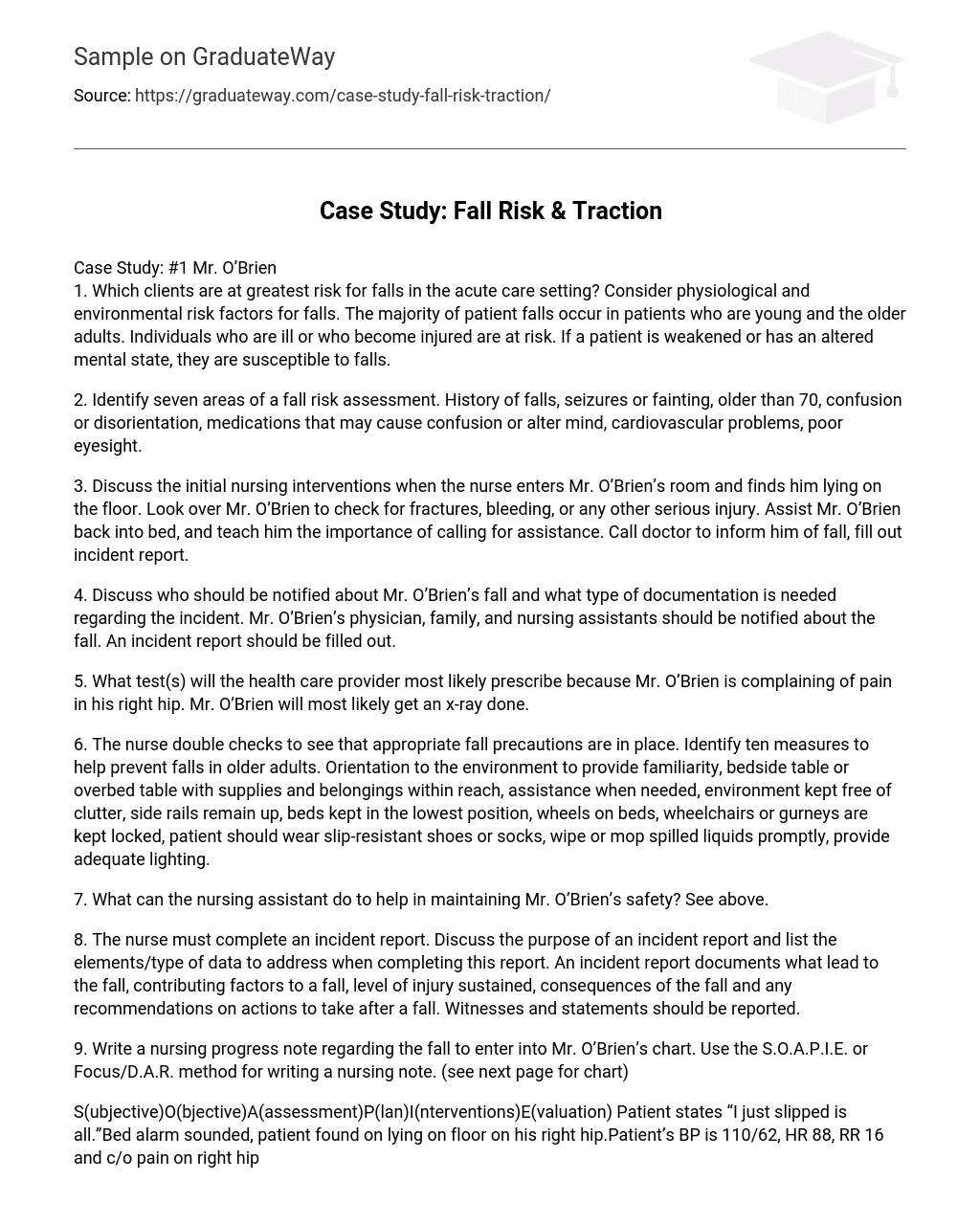- Prior to surgery, the health care provider chooses to place Mrs. Damerae’s right leg in Buck’s extension (traction). Why is this intervention prescribed prior to surgery? To maintain the desired traction pull and proper alignment; to prevent external rotation of the hip.
- A trochanter roll is another option for Mrs. Damerae. What is a trochanter roll and how would it be useful? A trochanter roll is a wedge (usually a rolled towel) placed from the crest of the ilium to mid-thigh to prevent external rotation of the hip when the patient is in a recumbent position.
- How might Mrs. Damerae’s age affect her hospitalization and recovery? The elderly are more prone to hip fractures due to degeneration of their bones. She may take longer heal due to her age.
- Briefly discuss how Mrs. Damerae’s past medical history played a role in her injury. Her osteoporosis made her susceptible to fractures due to a bump or fall, which she had.
- Mrs. Damerae’s surgeon informs her of the potential complications of hip surgery. Identify at least three complications the surgeon will address. Mortality rate due to blood clots, pneumonia or infection. Dislocation is common, as is infection or thromboembolism.
- Prioritize five nursing diagnoses appropriate for Mrs. Damerae following surgery. Risk for infection, risk for bleeding, risk for falls, impaired walking, impaired comfort.
- Explain how the nurse should move Mrs. Damerae in order to position her safely on her side to wash her back. Should move patient on unaffected side, with abduction pillow in place.
- The nurse applies graduated compression stockings (TEDs) and sequential compression devices (SCDs) as prescribed. What is the rationale for these interventions? To increase venous circulation to the heart and prevent pooling of blood.
- Mrs. Damerae asks for assistance to the bathroom. The nurse checks to see that the appropriate equipment is available in the bathroom before assisting the client to ambulate. What is the nurse looking for in the bathroom? A raised toilet seat and possible bars to assist patient.
- Mrs. Damerae is assisted back to bed. She asks that the head of her bed be raised so she can read. How high should the head of bed be raised and why? 30 or less is preferable, as to avoid flexion or external rotation.
- Mrs. Damerae is seated in a reclining char. What reminders will the nurse give Mrs. Damerae regarding positioning while sitting and why is positioning so important? Do not cross legs, do not get up at 90 degree angle. Positioning is important as to not dislocate hip.
- Identify the indications of a possible hip dislocation that the nurse should watch for. One leg shorter than the other, pain, inability to move, loss of feeling in foot or ankle.
- If the nurse notices any of the above signs, discuss the appropriate action for the nurse to take. Notify charge nurse and physician.
- Alendronate sodium is prescribed for Mrs. Damerae. What is the rationale for the use of alendronate sodium? Discuss the client education regarding proper administration to maximize the benefits of alendronate sodium and adverse effects. Increases bone mass and reduces incidence of fractures, including those of the hip and spine. Teach patients to take at least one half hour before the first food, beverage or medication of the day with plain water only, as food and liquids will reduce absorption of the medication. Wait 30 minutes after taking the medication to eat, drink or take other medications. There are gastrointestinal adverse reactions.
- Following discharge from a rehabilitation unit, a visiting nurse will provide follow-upcare for Mrs. Damerae. On the first home visit, the nurse conducts a home safety assessment. Identify at least five components of a safe home environment. Working smoke detector inside the home, nonskid bath mats, no throw rugs, prescription and over-the-counter medication is in a safe place, grap bars in the bathrooms, adequate lighting, steps or stairs should have handrails, no clutter, keep stairs or walkways clear, hazardous items are secured and in containers.
Case Study: Fall Risk & Traction
Cite this page
Case Study: Fall Risk & Traction. (2016, May 20). Retrieved from
https://graduateway.com/case-study-fall-risk-traction/





